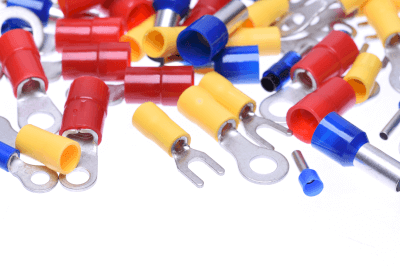What Is a Closed-End Wire Connector?

A closed-end wire connector is a terminal component used to connect two or more electrical wires by crimping.
Electrical wiring uses copper as the core wire, which has extremely low resistance. Therefore, by bringing two or more core wires into contact with each other, electricity can be supplied to the end of the wiring. However, simply twisting the wires to make contact will generate contact resistance, which can cause sparking or ignition. To reduce contact resistance, when wiring is connected, the wires are stored in crimp terminals and held together with a crimping tool to make a strong connection.
A closed-end wire connector is a type of crimp terminal that is closed on one side.
Uses of Closed-End Wire Connectors
Closed-end wire connectors are used to connect new equipment as well as repair wiring in industrial equipment when the wiring has been pulled apart by a strong impact. Since it does not support wiring with a large cross-sectional area, it is used for connecting relatively thin wiring of 0.75 to 8 mm2.
For connection of new equipment, it is used to connect the lead wires of equipment to the power supply side. Electrical products with specific uses are delivered with the power wiring called lead wires exposed. Closed terminals are sometimes used when connecting these to a power supply device.
Principle of Closed-End Wire Connectors
Closed-end wire connectors are connection terminals and have a very simple structure. Specifically, it is divided into a conductor part and a sheathed part.
The conductor part is a metal cylinder, which is crushed to form a tight fit between the wires. It is only about 1mm or less in thickness. Therefore, it can be easily crushed by using a crimping tool. The feature is that the conductor entrance is slightly widened so that wires can be easily inserted. The material used is basically copper, the same material used for wiring.
The sheathed part covers the entire conductor except for the wiring entrance of the conductor section. Since it must be electrically insulated from its surroundings, an insulator is used. In most cases, inexpensive nylon is used. As the working voltage increases, simple insulation with nylon is dangerous, so the upper limit of the working voltage is about 200V.
When actually crimping, the wires are twisted, and inserted from the wiring entrance until they hit the sheathed part, and then connected. At this time, if the core wire of the wiring protrudes from the covered part, it will lead to an electric shock or ground fault. During installation, it is essential to confirm that the core wire is completely inside the sheath and that it cannot be easily removed by pulling by hand.